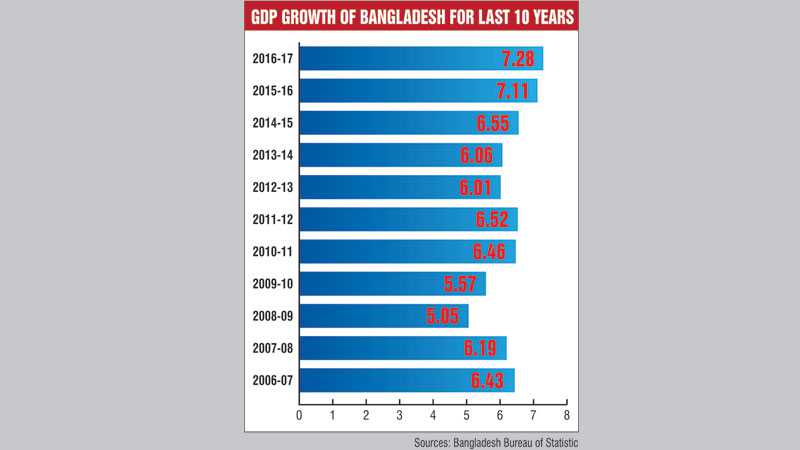GDP growth breaks all records in FY 17

It’s good news for the nation: Bangladesh broke all records to register 7.28 per cent GDP growth in the last fiscal year (FY 2016/17). Economists say the growth rate was very impressive, though there are a few questions regarding the major indicators, such as remittances, private sector investments, and slow export growth, which were not positive.
The per-capita income of Bangladesh reached USD 1,610 in the last fiscal year, according to the Bangladesh Bureau of Statistic (BBS), which revealed the final estimate of the gross domestic product for FY 2016–17.
It was estimated to be USD 1,602 in the provisional report of the yearly economic survey for the last fiscal year before the placement of the national budget proposal of the current fiscal year in Parliament in June this year.
“The GDP growth finally stood at 7.28 per cent in the last fiscal year,” said Planning Minister AHM Mustafa Kamal while briefing reporters after the Executive Committee of the National Economic Council (ECNEC) meeting held at the National Economic Council (NEC) conference room in Sher-e-Bangla Nagar in the city yesterday with ECNEC chairperson and Prime Minister Sheikh Hasina in the chair.
Earlier, the government had envisaged a provisional growth rate of 7.24 per cent in the last fiscal year. “The full and final statistics will be disclosed in detail on Thursday,” Kamal said.
The Bangladesh government had set a growth target of 7.2 per cent for the 2016/17 fiscal year. In the 2015/16 fiscal year,
the GDP growth was 7.11 per cent with a size of Tk. 1,732,864 crore, and per-capita income at USD 1,465, or Tk. 118,131.04.
AHM Mustafa Kamal also informed that the per-capita income had increased to USD 1,610 in the last fiscal year, up from the provisional estimate of USD 1,602.
Besides, he said, the size of the GDP stood at USD 250 billion, but it had taken around 34 years after the War of Independence to lift the country’s GDP to USD 100 billion. “Considering that, it’s a record achievement,” he said.
The planning minister said the per-capita income had increased due to the increase in the GDP growth. He also said that apart from Bangladesh, Cambodia and Ethiopia had attained over 7 per cent GDP growth in much lesser time among the other countries of the world. Among the three major growth sectors, he said industry had achieved the highest growth of 10.22 per cent in the last fiscal year, followed by 6.69 per cent by the service sector, and 2.97 per cent by the agricultural sector.
Mustafa Kamal also expressed the hope that the country’s GDP growth would reach over 8 per cent by 2019, while it would be within 9 to 10 per cent by 2030. “If we can maintain that, we will be able to become a developed country by 2041,” he added.
The planning minister also partially disclosed the inflation statistics for September, which stood at 6.04 per cent, slightly higher than the 6.02 per cent registered in August. The inflation figure included the overall food and non-food items. The lead economist Zahid Hussain of the World Bank’s Dhaka office told the Independent that a 7.28 per cent growth rate, the highest ever in the history of Bangladesh, was very impressive. He, however, said there were certain questions about the growth, as significant indicators of the economy were not clear such as slow phase of export growth and private sector investment.
Former adviser to the caretaker government Dr AB Mirza Azizul Islam said the supportive document did not support the growth rate. He also said the growth of private sector investment and exports, which were major players in GDP growth, were not positive.
Source: http://www.theindependentbd.com